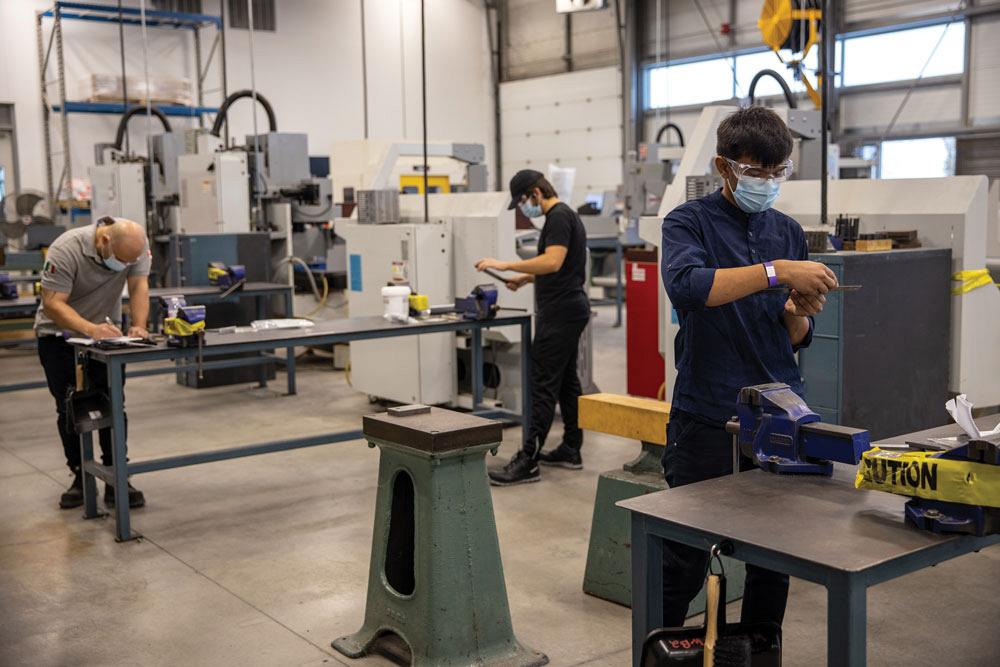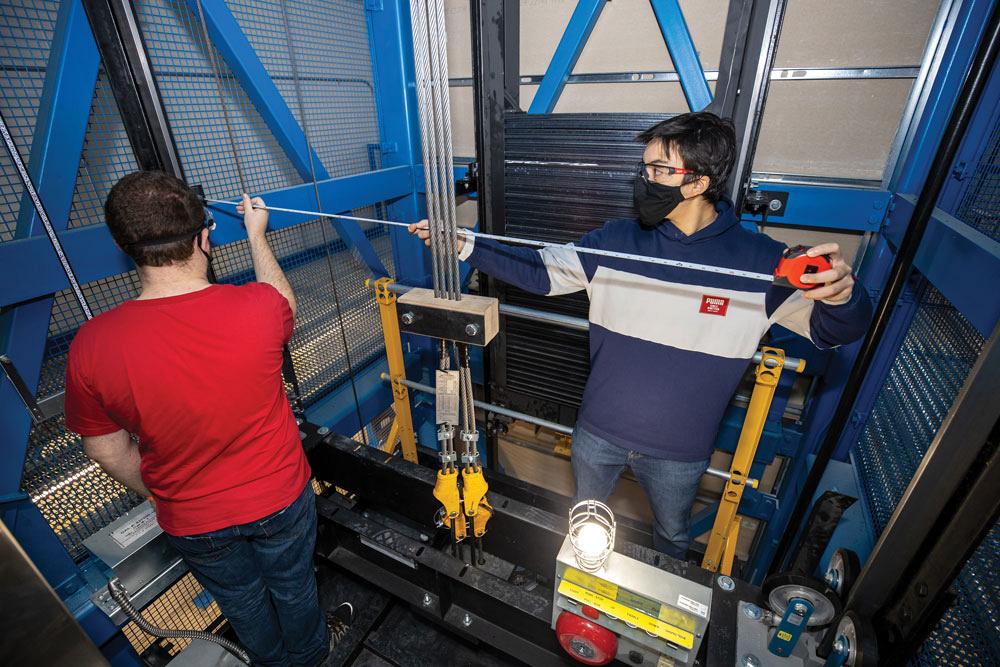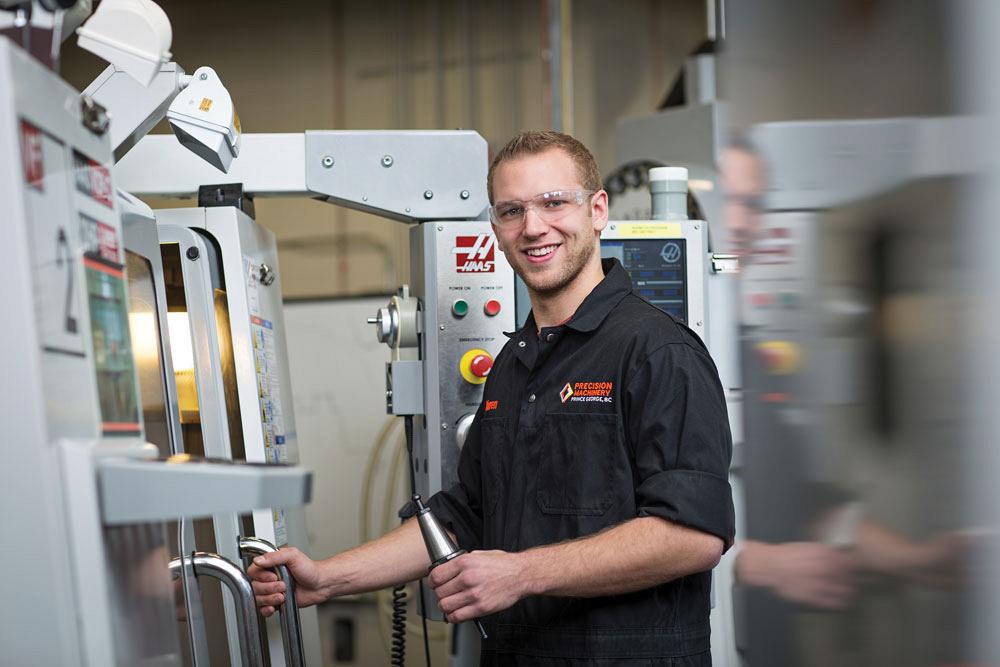Associate Editor
- FMA
- The Fabricator
- FABTECH
- Canadian Metalworking
A pandemic approach: Part II
Canada’s colleges have been forced to rethink skilled trades training
- By Lindsay Luminoso
- April 23, 2021
- Article
- Health & Safety

One of the biggest challenges Mohawk has faced during the pandemic is ensuring students receive lab time. The lab offers necessary equipment and hands-on training that cannot always be replicated in a virtual setting. Joshua McGurk/Mohawk College
In Part II of this two-part series we look at how two colleges, Northern Alberta Institute of Technology (NAIT) and Mohawk, rose to challenges the pandemic posed and adapted to meet student needs.
Canada’s skilled trades programs spent much of 2020 adapting to meet strict pandemic protocols, making in-person learning difficult. Educators and administrators rose to the challenges to find ways to make skilled trades training accessible to students and ensure that those enrolled in the program were able to complete coursework with as little interruption as possible.
Mohawk College
Mohawk College of Applied Arts and Technology was founded in 1966 in Hamilton, Ont. It currently has three main campuses in Hamilton, Stoney Creek, and Mohawk-McMaster Institute for Applied Health Sciences at McMaster University. There are approximately 32,500 full-time and part-time students, with 4,000 of those enrolled in apprenticeship programs.
Industry Focus. The college is focused on having the capabilities and flexibility to work with industry to develop the necessary trades training. It’s important to know exactly what industry expects from new talent not just in terms of skills and familiarity within the trades, but also their multifaceted skill sets.
“There is a crossover of skills opening up,” said David Santi, dean, School of Engineering Technology, Mohawk College. “Whether you are a machinist by trade or an engineer, there is a lot of crossover in what you have to know and do, especially as it relates to advanced manufacturing (digital and artificial intelligence, robotics, internet of things). We see a lot of implications with automotive and transportation, autonomous vehicles, electrification, and many new manufacturing systems being managed remotely. We are no longer waiting for something to break to rely on skilled trades. People are getting information in advance so that they can schedule a maintenance application in advance of failure and extending the life cycle of equipment. It's a converging field of technology.”
Mohawk works closely with industry from a post-secondary training perspective. It has program advisory committees that are key drivers regarding what industry needs in trades training for post-secondary programs. An annual review of curriculum is based on how the program is structured and it is audited for quality.
“When we do any of our strategic planning, we are working with our program advisory committees and industries, requesting their feedback,” said Wayne Ostermaier, dean, Marshall School of Skilled Trades & Apprenticeship, Mohawk College.
When it comes to metalworking, Ostermaier is seeing more need for diversified skill sets.
“Industry wants workers to be able to do other tasks outside of their trade classification, based on process and manufacturing needs,” he said. “A new credentialing aspect the government has been talking about is going to be critical as we move forward. We will need to focus on that ongoing learning initiative as skilled trades change. The key is flexibility.”
Advanced Manufacturing and Opportunities. Industry is changing rapidly. Whether it’s autonomous vehicles or advanced composites for aircraft, students need to be exposed to a range of the latest and greatest technology.

According to Ostermaier, industry wants workers to be able to do other tasks outside of their trade classification, based on process and manufacturing needs. And the colleges will need to focus on that ongoing learning initiative and flexibility as skilled trades change. Joshua McGurk/Mohawk College
“There are still viable careers in manufacturing, and the world is not going to run without plumbers, electricians, pipefitters, automotive repair people, fabricators, machinists, and more,” said Santi. “Those fields will always be in place, but the equipment they use and how they do their jobs are going to change. The materials we use and the whole circular design economy are going to change. The end of waste is not too far away. How will that change now in metal manufacturing? Being able to make something easy and inexpensive might not be acceptable anymore. There’s a whole world of new ideas emerging, and significant thought needs to go into how it all fits together.”
COVID-19 and Student Learning. Santi noted that one of the biggest challenges Mohawk has faced during the pandemic is ensuring students receive lab time. There is only so much a student can do online; the lab offers necessary equipment and hands-on training that cannot always be replicated in a virtual setting; and it has really emphasized the importance of apprenticeships.“From an apprenticeship or technologist program standpoint, it has always been a core of theory and hands-on training, but we're introducing augmented reality/virtual reality [AR/VR] and simulation,” said Ostermaier. “These AR/VR and simulation activities and tasks are documented, allowing for a more consistent transfer of knowledge. If a student was in the class or the lab, and maybe didn't get it, he or she can go back online and do it again until they're comfortable with it.”
Prior to COVID, the apprenticeship program was all face-to-face learning, even theory. But the department moved everything, including theory, online. For labs, the college has to work within the confines of government and public health guidelines, meaning that everything is scaled down. Programs now are scheduled for in-person learning over seven days a week to ensure they are meeting program requirements.
The Future of Skilled Trades Training. The pandemic has forced many colleges to move to online teaching, which has been a long and tedious process that was done out of necessity. And although there have been many positive outcomes, there still needs to be a strategy behind how the training programs will move forward.
“We have to gather significant data on what's working,” said Ostermaier. “We have to get feedback from faculty, industry, and students before we continue down any one path. We want to adapt weekly and monthly based on circumstances and flexibility is required, but we have to ensure that we are providing the quality education that meets industry needs in the most effective way possible.”
The college hasn’t seen a significant decline in enrollments, and Santi guesses that this may be because of the pandemic, not despite it. With limitations on what people can do, starting school and better positioning oneself for a good job opportunity just makes sense. But the million-dollar question is: What will the workforce look like in two or three years?
Santi has been thinking a lot about how to train students, and he is focused on developing a factory-type training program. He noted that processes shouldn’t be thought of as separate units; factory thinking looks at the interconnectedness of all aspects of the manufacturing environment. Students should be able to think about the entire supply chain from design, maintenance, and manufacturing to quality and more.
“We should be using that factory learning environment, whether you're a tradesperson, engineer, or a business student, to give that real-world understanding,” said Santi. “We teach some of the practical stuff in our labs, but to have a factory that operates and produces something could be a real game-changer in education. We've modelled it out on paper and now we've got to figure out how we can build something in partnership with other educational institutions and industry. It’s so important for students to understand and experience all elements of production control, supply chain, on-time delivery, factory maintenance, delays, customer relations, production changes, breakdown, and the end-to-end processes of a production operation.”
Northern Alberta Institute of Technology (NAIT)
Edmonton-based NAIT is a polytechnic and applied sciences institute founded in 1962. It offers approximately 120 credit and apprenticeship programs to over 21,000 students. With about 5,000 students registered in apprenticeship training, NAIT is considered one of the largest trades trainers in Canada.
Industry Focus. A significant percentage of parts produced in Alberta are large components, and there is a focus on the oil and gas sector. Shops in the region tend to be large and have large, multiaxis machines that can complete a part in one cycle versus moving the part around the shop. In recent years there has been a big push to retool, diversify, and create more connected environments.

With an aging workforce, more new workers are needed, and the pandemic has accelerated many retirements. New workers need to come in with diverse skill sets and a holistic view of the trades. NAIT
“A lot of businesses are moving outside of their traditional industries like the energy sector,” said Ronan Murray, chair, CNC machinist technician program, NAIT. “I'm seeing a lot of businesses looking for work in other industries and trying to become more flexible and take risks. This needs to track with how we train our students too.”
There is a push to train people to operate many different and advanced technologies, which comes from an industry need for multiskilled individuals. With an aging workforce, more new workers are needed, and Murray noted that the pandemic has accelerated many retirements. New workers need to come in with diverse skill sets and a holistic view of the trades.
“Several years ago, many people thought we shouldn't be teaching CAD/CAM to beginners, but that attitude seems to have changed,” said Murray. “And people are seeing the value in developing more online content with real-time and on-demand interaction. We're trying as an institute and training facility to be more flexible and creative in the way we teach.”
Advanced Manufacturing and Opportunities. In Alberta, companies that are staying successful throughout the pandemic tend to focus their time and money on retooling and expanding their in-house capabilities. Murray said that many of the local shops are investing in new, more efficient processes and machines, the latest technology to make it easier and faster to produce parts. Some are even developing cells to do work in segments that don’t traditionally use them.
“We want to give our students some awareness of all these new things that are happening,” said Murray. “We are seeing lights-out manufacturing more than ever before, and we are seeing more robots and automation, multiaxis machining, and additive manufacturing in our shops. Our new talent will need to be continuously learning. They need to stay up to date with the changes in technology, software, and machine controls. Continuous learning is going to be big, and that's something we need to impart in our students.”
COVID-19 and Student Learning. Murray stressed that the pandemic presented a significant challenge for the college, but also a new and fun opportunity. In March 2020, when everything started to shut down, it was hard to know the best path forward. The college moved onto its learning management system, which was not traditionally used for apprenticeship programs.
“Our learning management system has renewed the focus on how we can create flexible pathways for learners,” said Murray. “We're seeing possibilities that we didn't see before. We've seen advantages to online; we can accommodate more students in the online environment. So, we don't have the constraints of infrastructure, which is great. Another advantage is that students can go back and look at the information in the online sessions, making learning more accessible.”
Although the pandemic forced the department to move much of its learning online and get creative with how content is being taught, the college has since adopted a blended format of both online and in-person learning.
“We still do face-to-face training,” said Murray. “We’ve got approximately 150 students a week coming through our building, and we’ve enhanced many of our health and safety protocols to account for COVID-19.”
Due to provincial restrictions, the college has limited class sizes and students are spread out throughout the lab area. Murray said that the department invested in voice amplifiers in the shop to make it easier for students to hear, especially as they have to wear masks and required PPE. He added that they realized they should have been using amplifiers all along as the lab can be quite noisy with all the machines running, and it will be something they continue to do going forward.

According to Murray, a lot of businesses are moving outside of their traditional industries like the energy sector and are looking for work in other industries, trying to become more flexible, and take risks. This needs to track with how the college trains its students. NAIT
The Future of Skilled Trades Training. Online learning has also alleviated some of the issues with having students pulled from the workforce two months out of the year for in-class training.
“I think we'll be able to work better with employers,” said Murray. “It won’t be all online -- we recognize in the school of skilled trades that the hands-on aspect is so important, and being able to feel, see, and hear what's going on is a huge part of learning. But with that in mind, we are looking for ways to offer both hands-on and less disruptive learning.”
For this to work well, students need to have the skills to use technology effectively. Throughout the pandemic many schools have adapted to online learning and new technologies. But Murray also noted that hand in hand with this, tradespeople need to understand that professional qualities like communication skills, collaborative skills, and flexibility are going to be hugely important going forward.
For the most part, the pandemic has decreased the number of students enrolled in programs across the board at NAIT for the 2020/21 academic year. And Murray suspects that it's easier now for companies to find skilled workers because there has been a reduction in opportunities, increasing the talent pool.
“Our focus at the industry level has to be on a high level of excellence and training and to keep the students engaged and to spread the word about our program,” he said. “My hope for tradespeople is that there will be opportunities with emerging technologies like alternative energy, manufacturing, renewable technologies, waste management, and carbon capture initiatives. There hopefully will still be some opportunities and traditional industries as well. Our opportunities lie in continued emphasis on automation, robotics, and emerging technologies. The basic skills will still be important at our level for training so that students can tie the past to the present to the future.”
This past year has been a process of development and discovery for Murray and NAIT. Once the current cohort of students has graduated, the college will be able to take a step back, see what worked, and strategize for upcoming cohorts.
Associate Editor Lindsay Luminoso can be reached at lluminoso@canadianmetalworking.com.
Mohawk College, www.mohawkcollege.ca
NAIT, www.nait.ca
About the Author

Lindsay Luminoso
1154 Warden Avenue
Toronto, M1R 0A1 Canada
Lindsay Luminoso, associate editor, contributes to both Canadian Metalworking and Canadian Fabricating & Welding. She worked as an associate editor/web editor, at Canadian Metalworking from 2014-2016 and was most recently an associate editor at Design Engineering.
Luminoso has a bachelor of arts from Carleton University, a bachelor of education from Ottawa University, and a graduate certificate in book, magazine, and digital publishing from Centennial College.
subscribe now


Keep up to date with the latest news, events, and technology for all things metal from our pair of monthly magazines written specifically for Canadian manufacturers!
Start Your Free Subscription- Industry Events
MME Winnipeg
- April 30, 2024
- Winnipeg, ON Canada
CTMA Economic Uncertainty: Helping You Navigate Windsor Seminar
- April 30, 2024
- Windsor, ON Canada
CTMA Economic Uncertainty: Helping You Navigate Kitchener Seminar
- May 2, 2024
- Kitchener, ON Canada
Automate 2024
- May 6 - 9, 2024
- Chicago, IL
ANCA Open House
- May 7 - 8, 2024
- Wixom, MI




















